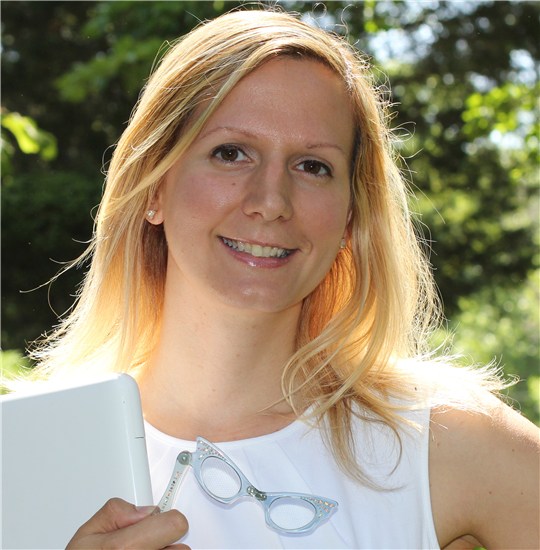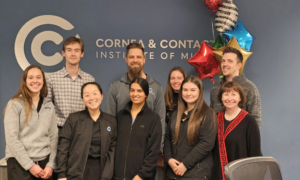By Cheryl G. Murphy, OD

March 11, 2015
Massive open online courses, also known as MOOCs, are a fun and often free way to satisfy your curiosity about vision science and fields outside of optometry entirely. MOOCs give you access to seminars on topics that you wouldn’t find at even the largest optometric conferences.
Taught by professors at top universities such as Duke, Brown, Yale and Caltech, these online classes present a series of video lectures, reading materials and discussion forums on the topic of your choosing, and are available at no cost to you through web sites like coursera.com. I am currently enrolled in a free, eight-week long online course on Visual Perception and the Brain taught by Dr. Dale Purves, a professor and researcher at Duke University.
Each week, a link to a video module is sent to my registered e-mail address. The link takes me to a series of short videos that are pertinent to that week’s topic. In the Visual Perception and the Brain course, topics we have covered so far are: the Phenomenology of What We See, the Organization of the Visual System and Conceptions in How Vision Works. After I watch each of the video segments, I then take a 10-question multiple choice quiz to confirm my understanding of the material.
I took notes right from the beginning, and I am glad I did, because, even though I’m an optometrist (and have worked as a research assistant in two vision science laboratories), the quizzes have not been a piece of cake! Sure I get at least eight out of the 10 questions correct, but as an eyecare professional, I was banking on perfect scores! Luckily, we are allowed three attempts to change wrong answers and improve our final score for each quiz. I like that we are getting tested because it makes me pay attention and not zone out during the videos, and as I said, I am also happy I have taken notes (and even made sketches) of concepts covered in the course thus far. I plan on using my notes, and what I have learned in this course, when creating my “vision tip of the week,” an interesting fact about vision science that I share weekly on my professional social media and on the dry-erase board in my exam room.
Along with the quizzes, final grades in the online class are also determined by a peer assessment, an essay of 500-1,000 words that I have to write on a relevant topic chosen by Dr. Purves. The essay will be reviewed and graded by five of our peers in the class. He is having us write about the Ponzo effect, but does not suggest that we attempt the essay until we are at least half way through the course.
Dr. Purves is an outstanding professor, and his video lectures have been topnotch. I have enough background knowledge to appreciate how eloquently he is presenting topics about vision science and the brain that may be traditionally thought of as tough for teachers to describe and for students to understand. He is doing a great job of keeping things simple yet still intriguing and challenging. It is interesting to go into the discussion forums for the course, especially the one where people taking the course introduce themselves, what country they are from, what they do for a living and what they hope to gain from this course. There are so many people from other countries signed up, and their backgrounds and professions vary greatly.
At the end of the free course, you get a certification of completion (in this case from Duke University) or you can choose to complete a targeted sequence of four courses pertaining to a certain topic in order to receive a “specialization” in that area. To complete a specialization, you need to pay for three out of the four courses (at $49 each), so keep this in mind when deciding what to take next. You could always choose a course under a different topic (there are many science topics to choose from), and again, take that entire course for free.
These courses are not for college credit or for continuing education credit in optometry, but I do think they are valuable and different than what optometrists would take at a CE event. Even if you choose to pay and complete a specialization sequence, since every week of each eight-week course may take 1-2 hours of your time, and you are taking four courses to complete a sequence, you are getting more knowledge (64 hours) for less money ($147) than you would spend taking a CE optometry course (1-2 hours) at a convention or event, which may cost anywhere from $50 to $103 per hour.
Also, remember, you can branch outside of your field and learn about something outside of optometry that you always wanted to explore. Additionally, it can be done from the comfort of your own home or office, at no cost to you, and taught by some of the best instructors from the best universities in the world. Next, I think I may take a writing course or one on journalism to advance my skills in science writing.
The only question left to answer is: What do you want to learn about today?
Have you ever heard of a MOOC? What classes have you taken outside of optometry continuing education courses? Outside of science entirely? How much money do you spend on CE classes per year? Would you like to learn about anything outside of optometry?
Cheryl G. Murphy, OD, practices in Holbrook, NY. You can like her on Facebook or follow her on Twitter @murphyod. To contact her: murphyc2020@gmail.com.



























